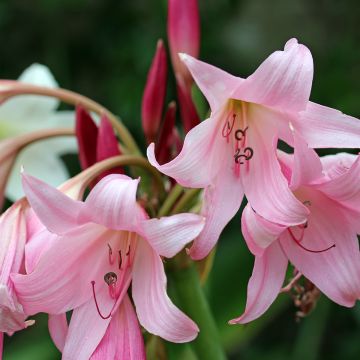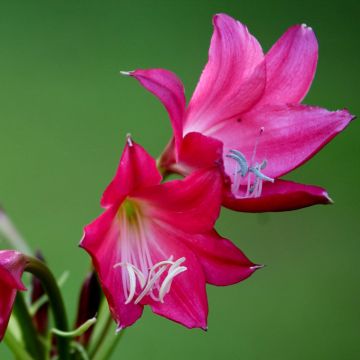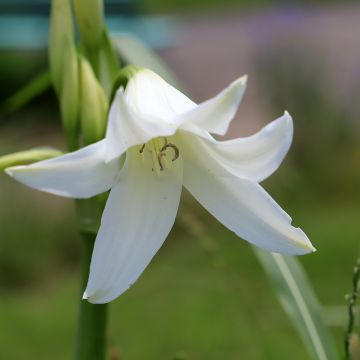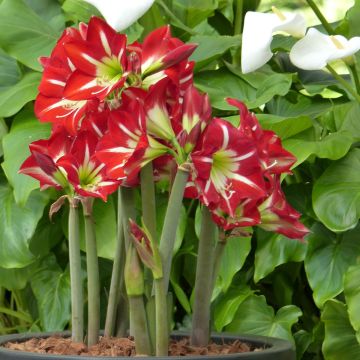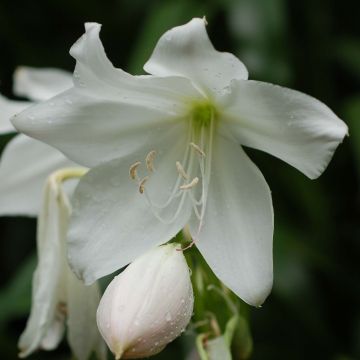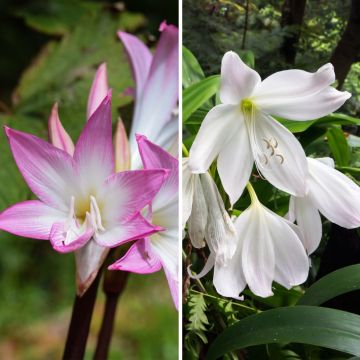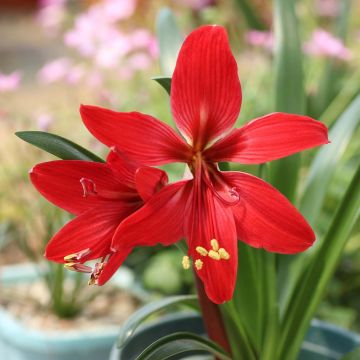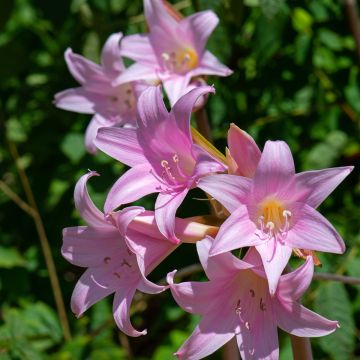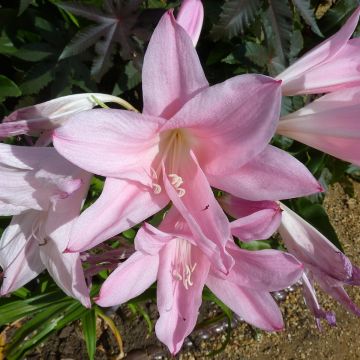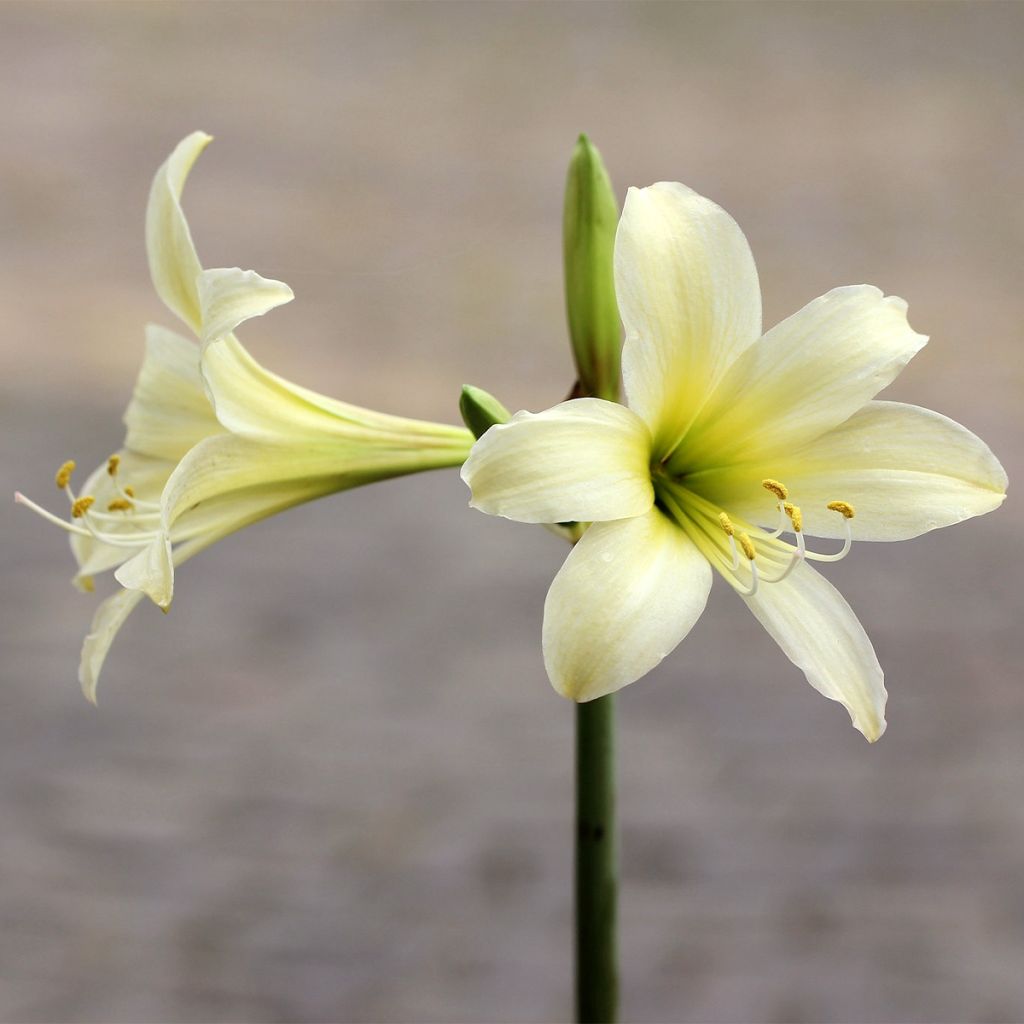

Amaryllis sonatini Marrakech - Hippeastrum de jardin
Hippeastrum Marrakech
Hippeastrum sonatini Marrakech
Amaryllis, Hippeastrum
This item cannot be shipped to the selected country
Delivery charge from €5.90
More information
Schedule delivery date,
and select date in basket
This plant carries a 6 months recovery warranty
More information
We guarantee the quality of our plants for a full growing cycle, and will replace at our expense any plant that fails to recover under normal climatic and planting conditions.
From €5.90 for pickup delivery and €6.90 for home delivery
Express home delivery from €8.90.
Does this plant fit my garden?
Set up your Plantfit profile →
Description
Hippeastrum 'Marrakech'® is a bulb that is resistant to light frost and can be grown in the ground in many regions without the need to dig up the bulbs in autumn. This beautiful variety offers flowers of a tender yellow with a pale green throat in summer. Its bulb, smaller than the Amaryllis that is forced to bloom for Christmas, also produces smaller but much more abundant flowers! It can produce up to 4 flowering stems, each carrying 3 to 5 funnel-shaped flowers. The floral stems, sturdy but stout, withstand the wind well. Plant them in small groups in a sunny but not scorching exposure or in partial shade. It is also a lovely plant for decorating the terrace or balcony.
From the Amaryllidaceae family, Hippeastrum is native to South and Central America. They are generally grown in pots in our latitudes and flower indoors during Christmas. Hippeastrum 'Marrakech' is a variety developed in the last twenty years by the Dutch company Barnhoorn Hippeastrum, with the aim of obtaining an Amaryllis that is hardy enough to be grown outdoors, even in cold climates. The result is a smaller, more floriferous amaryllis, tolerating temperatures as low as -8°C (17.6°F) for a very short period of time. The vegetation emerges from the ground in spring and disappears at the end of summer.
In full bloom, the 'Marrakech' variety forms a clump 30 to 40cm (12 to 16in) high in full sun and 30cm (12in) wide. In partial shade, the stems can reach 50cm (20in) in height. The plant blooms in June-July. The flowers, 6 to 12cm (2 to 5in) wide, are funnel-shaped and flared. Each one is composed of 6 pointed, slightly undulate, thick and iridescent petals. The heart of the flower is a tender green, releasing long yellow stamens. 4 to 5 flowers positioned back to back gracefully top 3 to 4 hollow stems. The leaves are linear, ribbon-like and shiny dark green. They dry up and disappear a few weeks after flowering, when the bulb goes into dormancy.
Planting a garden Amaryllis is very rewarding, and there is now a beautiful range available with various colours and shapes. This plant is very easy to grow and its growth is very rapid. This 'Marrakech' variety, with its light and bright flowers, naturally complements white, blue, red or purple flowers. Plant it in small groups, it will work wonders in a flower bed, border or in a beautiful enamelled terracotta pot, on the terrace or balcony. Planted in well-drained soil, the 'Marrakech' Amaryllis will come back every year, provided they are well protected under a thick layer of mulch in regions where the temperature drops below -8°C (17.6°F). They will also make excellent cut flowers, with a long vase life.
To speak of an Amaryllis here is actually a misuse of language directly related to an error made in the 18th century. It was Linnaeus himself who used it to name the American species. However, the name was already used for another beautiful flower, this one from South Africa. Conventionally, the designation Amaryllis was retained for both. And to distinguish them Hippeastrum was added to the first and Belladonna to the second. It must be said that both deserve this name: Amaryllis means "sparkling" and, in classical Greek literature, the plant was the subject of a pastoral poem in which the beautiful shepherdess Amaryllis dies of a love that will only be accessible to her after a terrible wound. From her blood will emerge beautiful bunches of red flowers. Since then, the term has become synonymous with lofty beauty.
Report an error about the product description
Hippeastrum Marrakech in pictures
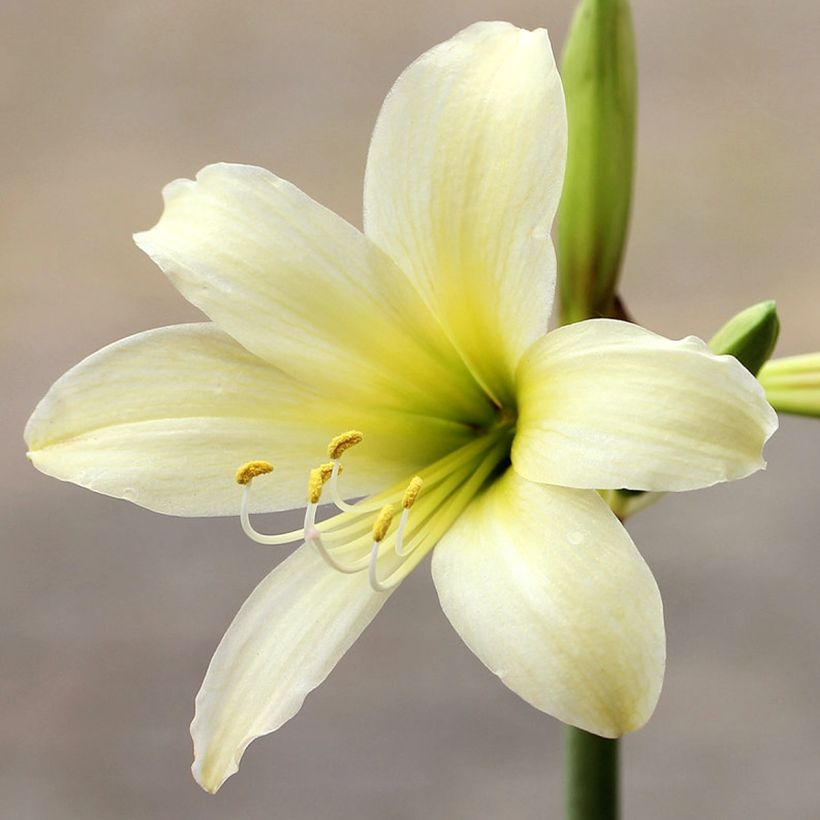

Plant habit
Flowering
Foliage
Botanical data
Hippeastrum
sonatini
Marrakech
Amaryllidaceae
Amaryllis, Hippeastrum
Cultivar or hybrid
Other Amaryllis and Crinums
Planting and care
How do I plant my Amaryllis? You can plant Amaryllis bulbs from October to the end of April. For pot cultivation, choose a pot that is not too large (one or two cm larger than the size of the bulb). Place a layer of drainage at the bottom for proper water flow. Mix half potting soil and half garden soil. Only bury the bulb halfway. Place the pot in a warm and bright location. Water sparingly until the stem appears. Then water daily.
Planting in the ground is completely possible in any good, well-amended garden soil, that is both rich and well-drained. In heavy soil, add coarse sand or small gravel to your mixture, and plant in a slightly raised bed (20cm (8in) is sufficient). The plant should not lack water during the entire period of growth and flowering. Hardy down to -8°C (17.6°F), make sure to plant the bulbs deeply and cover them with a thick layer of mulch before the first frost, this will protect them from both freezing temperatures and excess water.
Planting period
Intended location
Care
This item has not been reviewed yet - be the first to leave a review about it.
Haven't found what you were looking for?
Hardiness is the lowest winter temperature a plant can endure without suffering serious damage or even dying. However, hardiness is affected by location (a sheltered area, such as a patio), protection (winter cover) and soil type (hardiness is improved by well-drained soil).

Photo Sharing Terms & Conditions
In order to encourage gardeners to interact and share their experiences, Promesse de fleurs offers various media enabling content to be uploaded onto its Site - in particular via the ‘Photo sharing’ module.
The User agrees to refrain from:
- Posting any content that is illegal, prejudicial, insulting, racist, inciteful to hatred, revisionist, contrary to public decency, that infringes on privacy or on the privacy rights of third parties, in particular the publicity rights of persons and goods, intellectual property rights, or the right to privacy.
- Submitting content on behalf of a third party;
- Impersonate the identity of a third party and/or publish any personal information about a third party;
In general, the User undertakes to refrain from any unethical behaviour.
All Content (in particular text, comments, files, images, photos, videos, creative works, etc.), which may be subject to property or intellectual property rights, image or other private rights, shall remain the property of the User, subject to the limited rights granted by the terms of the licence granted by Promesse de fleurs as stated below. Users are at liberty to publish or not to publish such Content on the Site, notably via the ‘Photo Sharing’ facility, and accept that this Content shall be made public and freely accessible, notably on the Internet.
Users further acknowledge, undertake to have ,and guarantee that they hold all necessary rights and permissions to publish such material on the Site, in particular with regard to the legislation in force pertaining to any privacy, property, intellectual property, image, or contractual rights, or rights of any other nature. By publishing such Content on the Site, Users acknowledge accepting full liability as publishers of the Content within the meaning of the law, and grant Promesse de fleurs, free of charge, an inclusive, worldwide licence for the said Content for the entire duration of its publication, including all reproduction, representation, up/downloading, displaying, performing, transmission, and storage rights.
Users also grant permission for their name to be linked to the Content and accept that this link may not always be made available.
By engaging in posting material, Users consent to their Content becoming automatically accessible on the Internet, in particular on other sites and/or blogs and/or web pages of the Promesse de fleurs site, including in particular social pages and the Promesse de fleurs catalogue.
Users may secure the removal of entrusted content free of charge by issuing a simple request via our contact form.
The flowering period indicated on our website applies to countries and regions located in USDA zone 8 (France, the United Kingdom, Ireland, the Netherlands, etc.)
It will vary according to where you live:
- In zones 9 to 10 (Italy, Spain, Greece, etc.), flowering will occur about 2 to 4 weeks earlier.
- In zones 6 to 7 (Germany, Poland, Slovenia, and lower mountainous regions), flowering will be delayed by 2 to 3 weeks.
- In zone 5 (Central Europe, Scandinavia), blooming will be delayed by 3 to 5 weeks.
In temperate climates, pruning of spring-flowering shrubs (forsythia, spireas, etc.) should be done just after flowering.
Pruning of summer-flowering shrubs (Indian Lilac, Perovskia, etc.) can be done in winter or spring.
In cold regions as well as with frost-sensitive plants, avoid pruning too early when severe frosts may still occur.
The planting period indicated on our website applies to countries and regions located in USDA zone 8 (France, United Kingdom, Ireland, Netherlands).
It will vary according to where you live:
- In Mediterranean zones (Marseille, Madrid, Milan, etc.), autumn and winter are the best planting periods.
- In continental zones (Strasbourg, Munich, Vienna, etc.), delay planting by 2 to 3 weeks in spring and bring it forward by 2 to 4 weeks in autumn.
- In mountainous regions (the Alps, Pyrenees, Carpathians, etc.), it is best to plant in late spring (May-June) or late summer (August-September).
The harvesting period indicated on our website applies to countries and regions in USDA zone 8 (France, England, Ireland, the Netherlands).
In colder areas (Scandinavia, Poland, Austria...) fruit and vegetable harvests are likely to be delayed by 3-4 weeks.
In warmer areas (Italy, Spain, Greece, etc.), harvesting will probably take place earlier, depending on weather conditions.
The sowing periods indicated on our website apply to countries and regions within USDA Zone 8 (France, UK, Ireland, Netherlands).
In colder areas (Scandinavia, Poland, Austria...), delay any outdoor sowing by 3-4 weeks, or sow under glass.
In warmer climes (Italy, Spain, Greece, etc.), bring outdoor sowing forward by a few weeks.

































